Exploring the Diverse World of GPUs
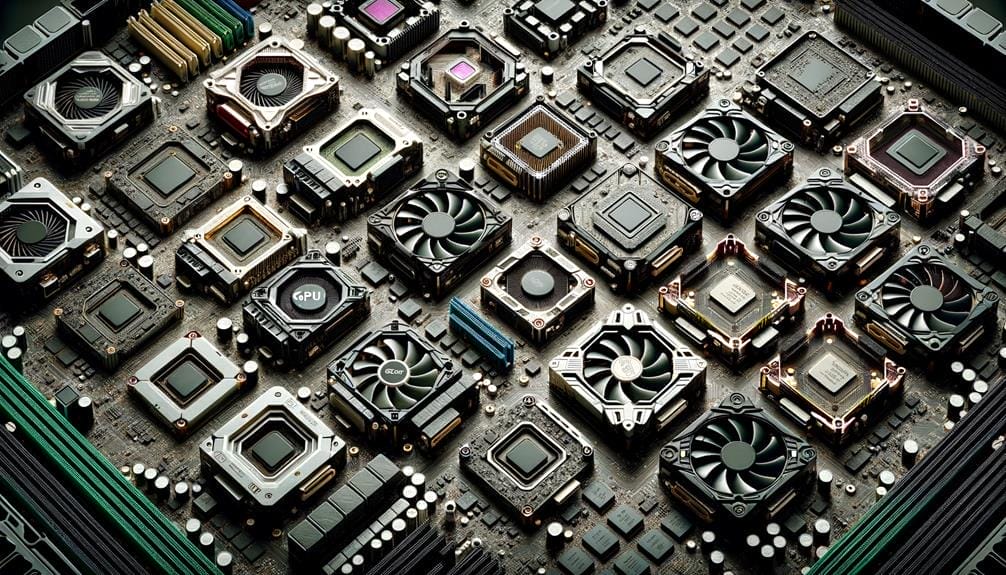
In the realm of technology, Graphics Processing Units (GPUs) are **pivotal** in driving innovation forward. They unveil a plethora of possibilities tailored to cater to the diverse preferences of all users. Whether your preference leans towards dedicated graphics cards, or you’re attracted to the convenience of integrated and external solutions, the GPU market has an extensive range of choices for you. If you’re intrigued by the ability of these remarkable technologies to enhance your digital life, stay tuned. You’re about to embark on an intriguing journey that might transform how you interact with your devices!
This article aims to delve into the intricacies of different GPU types, including dedicated graphics cards, AIB GPUs versus reference models, and various GPU designs. By exploring the characteristics, uses, and considerations associated with each type, readers will gain a comprehensive understanding of the diverse landscape of GPUs.
Furthermore, the concluding section will address common queries and provide insights into choosing the most suitable GPU type based on individual requirements. Join us in this exploration of the multifaceted world of GPUs and discover the ideal graphics solution for your needs.
Key Takeaways
- Dedicated Graphics Cards provide high graphical prowess and have their own memory pool.
- AIB partners tend to over-engineer GPUs for higher clock speeds and lower temperatures.
- Different types of GPU designs include open-air GPUs, blower GPUs, water cooled GPUs, integrated graphics cards (iGPUs), and external graphics cards (eGPUs).
- Open-air GPUs offer great performance-per-dollar, noise levels, and temperatures compared to other types of GPUs.
The Power of Dedicated Graphics Cards
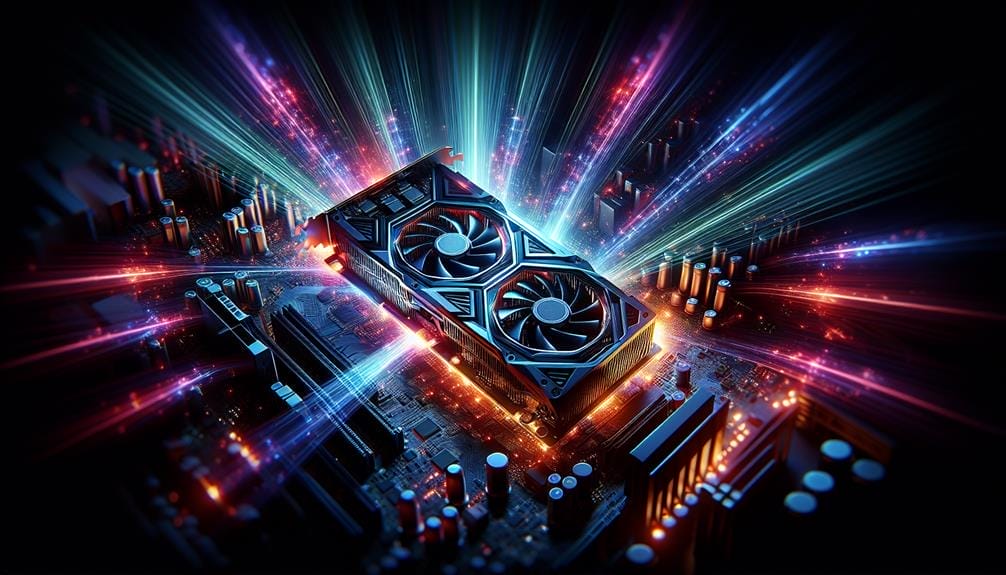
Dedicated graphics cards, renowned for their high graphical prowess and autonomous memory pool, are integral components for delivering exceptional visual performance across a wide range of workloads. The future of dedicated graphics cards is promising, with continuous advancements in technology aimed at maximizing gaming performance.
These cards offer superior capabilities in rendering high-resolution graphics, enabling smoother frame rates, and supporting real-time ray tracing for immersive gaming experiences. Their dedicated memory ensures efficient processing of complex visual data, enhancing overall system performance.
As gaming continues to evolve with higher demands for realistic graphics and seamless gameplay, dedicated graphics cards play a pivotal role in meeting these requirements.
With ongoing developments in GPU architecture and memory technologies, the future holds exciting potential for further elevating gaming performance through dedicated graphics cards.
AIB GPUs Vs. Reference Models
The evolution of dedicated graphics cards, renowned for their high graphical prowess and autonomous memory pool, has given rise to a significant distinction in the market between AIB GPUs and Reference Models.
AIB partners like ASUS and Gigabyte buy GPU dies from NVIDIA or AMD and equip them with custom shrouds, heatsinks, and RGB, often using open-air designs with multiple fans for better cooling. On the other hand, Reference Models (Founders Editions) are stylish but run hotter.
AIB partners tend to over-engineer GPUs for higher clock speeds and lower temperatures. The pros of AIB GPUs include better cooling and higher clock speeds, while the cons may involve a higher price and potential compatibility issues.
A comparison between AIB GPUs and reference models reveals that AIB GPUs offer more customization and improved performance, but at a higher cost.
Exploring Different GPU Designs
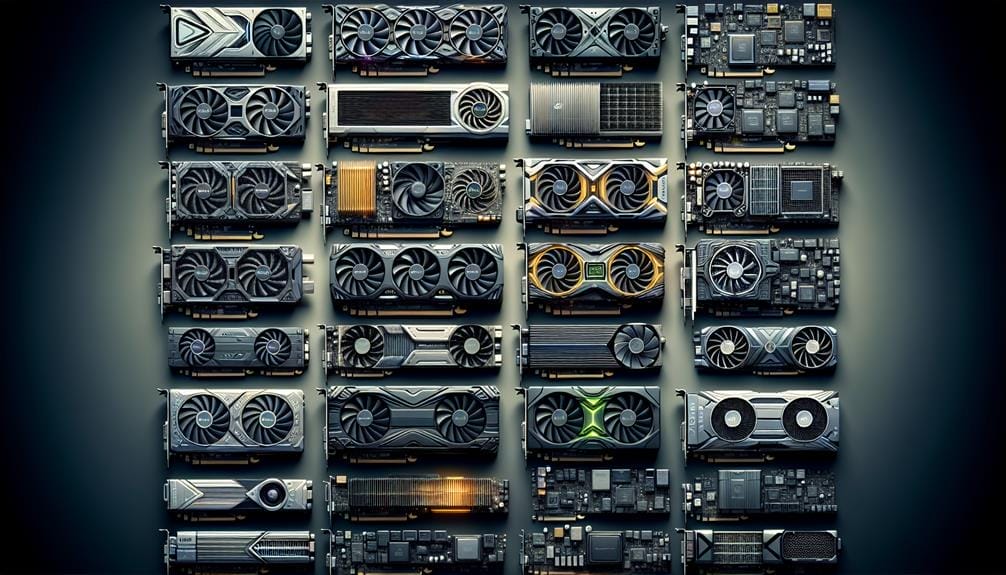
Different GPU designs offer unique features and performance capabilities, catering to the diverse needs of users in the computer graphics industry. When considering different GPU designs, it is essential to weigh the pros and cons of various cooling methods and compare their performance in gaming applications.
- Open-Air GPUs: Provide excellent performance-per-dollar, noise levels, and temperatures.
- Blower GPUs: Run hotter and produce more noise but are suitable for multi-GPU setups or small PC cases.
- Water Cooled GPUs: Utilize liquid-filled tubes for heat dissipation, but open-air designs are generally more efficient and cost-effective.
- Integrated Graphics Cards (iGPU): Ideal for undemanding workflows and light gaming, but not suitable for content creation.
- External Graphics Cards (eGPU): Offer additional graphics power for laptops and mini PCs, with potential performance loss depending on the Thunderbolt connection bandwidth.
Understanding GPU Characteristics
Exploring the intricate characteristics of GPUs provides insight into their performance and suitability for diverse computational tasks. When considering GPU selection, the advantages of dedicated graphics cards become apparent.
These cards offer high graphical prowess and have their own memory pool, making them suitable for various workloads. AIB GPUs, equipped with custom shrouds and heatsinks, offer higher clock speeds and lower temperatures compared to reference models.
Different GPU designs, such as open-air, blower, water-cooled, integrated, and external, cater to specific needs and preferences. Open-air GPUs provide great performance-per-dollar, while blower GPUs are suitable for multi-GPU setups or confined spaces. Water-cooled GPUs, though more expensive, offer efficient cooling.
Integrated graphics cards are adequate for undemanding workflows, whereas external GPUs can enhance graphics power for laptops and mini PCs.
Understanding these characteristics is crucial for making informed decisions when selecting a GPU.
Use Cases for Open-Air GPUs
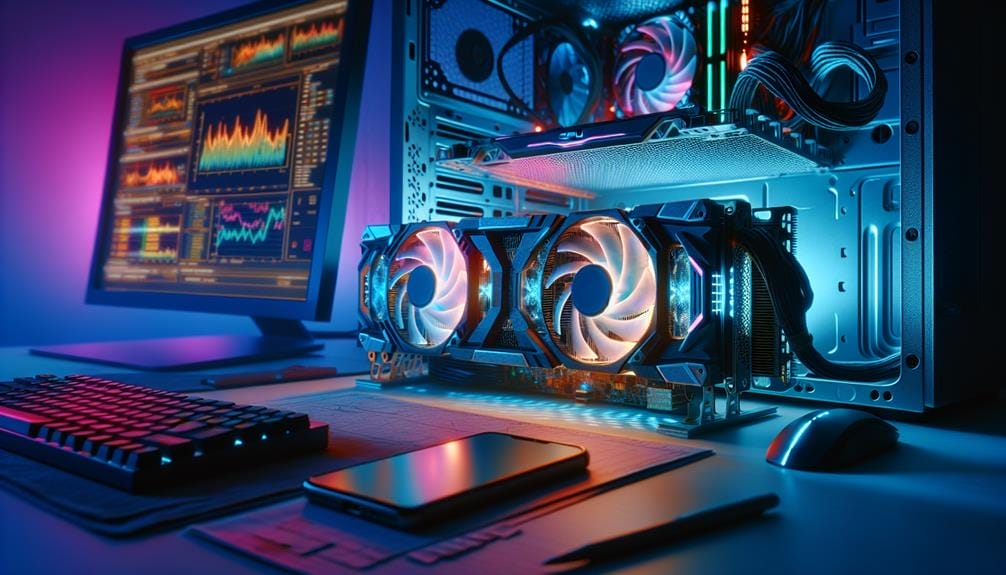
Optimal utilization of open-air GPUs is contingent upon understanding their specific applications and advantages in diverse computational scenarios. Open-air GPUs offer several advantages over blower-style GPUs, making them suitable for various use cases:
- Superior cooling capabilities, resulting in lower operating temperatures
- Reduced noise levels, providing a quieter working environment
- Better performance-per-dollar ratio, making them cost-effective
- Compatibility with larger PC cases, allowing for easier installation and maintenance
- Enhanced overclocking potential, leading to improved overall performance and efficiency
These advantages position open-air GPUs as the preferred choice for most users, particularly in gaming and content creation setups.
Conversely, blower-style GPUs suffer from drawbacks such as higher operating temperatures and increased noise levels, limiting their suitability for certain computational scenarios.
Benefits of Blower GPUs
The distinct advantages of blower GPUs are evident in their specialized design and targeted functionality, making them particularly suitable for specific computational environments and configurations.
Blower GPUs excel in scenarios where effective heat dissipation and directed airflow are crucial. Their unique shroud and fan design allow them to expel hot air directly out of the case, making them ideal for multi-GPU setups or small form factor cases where heat accumulation can be a concern.
However, it's important to note that blower GPUs typically run hotter and produce more noise compared to open-air designs. Additionally, their cooling efficiency may be limited when compared to other GPU types.
Understanding these advantages and limitations is essential when considering the suitability of blower GPUs for specific use cases.
Delving Into Water Cooled GPUs
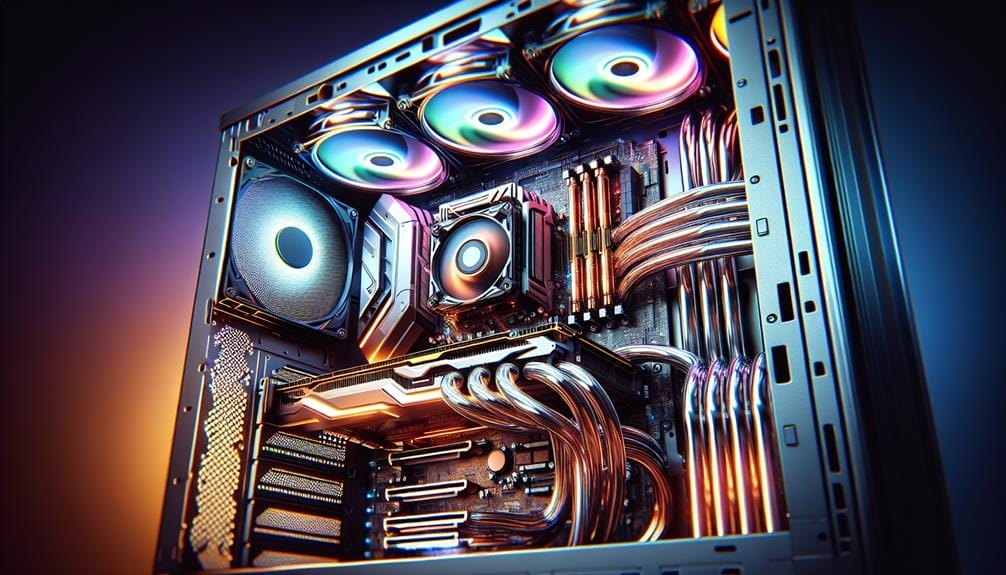
Delving into Water Cooled GPUs reveals a sophisticated cooling solution that harnesses liquid-filled tubes to efficiently dissipate heat from the graphics card, catering to the needs of enthusiasts and those seeking quieter and potentially more effective thermal management.
Advantages of Water Cooling:
- Superior heat dissipation capabilities.
- Reduced noise levels compared to air cooling.
- Potential for higher overclocking performance.
- Enhanced aesthetic appeal with customizable liquid cooling systems.
- Long-term cost-effectiveness due to reduced wear on the GPU.
When comparing water cooling to air cooling, water cooling tends to offer superior thermal performance and noise reduction, making it an attractive option for those seeking optimal cooling solutions for their high-performance GPUs.
The Evolution of Integrated Graphics Cards
The advantages of integrated graphics cards have steadily expanded their suitability for undemanding workflows and light gaming, offering an alternative to dedicated graphics cards and a potential backup solution in the event of dedicated graphics card malfunction.
The evolution of integrated graphics has seen significant improvements in performance and capability. Modern integrated GPUs are now capable of handling tasks that were previously only achievable with dedicated graphics cards.
While integrated graphics may not match the raw power and performance of dedicated GPUs, they offer considerable value for casual users and those with budget constraints.
Additionally, advancements in integrated graphics technology have led to better power efficiency and reduced heat generation, making them an attractive option for thin and light laptops and small form factor PCs.
Harnessing the Potential of External GPUs
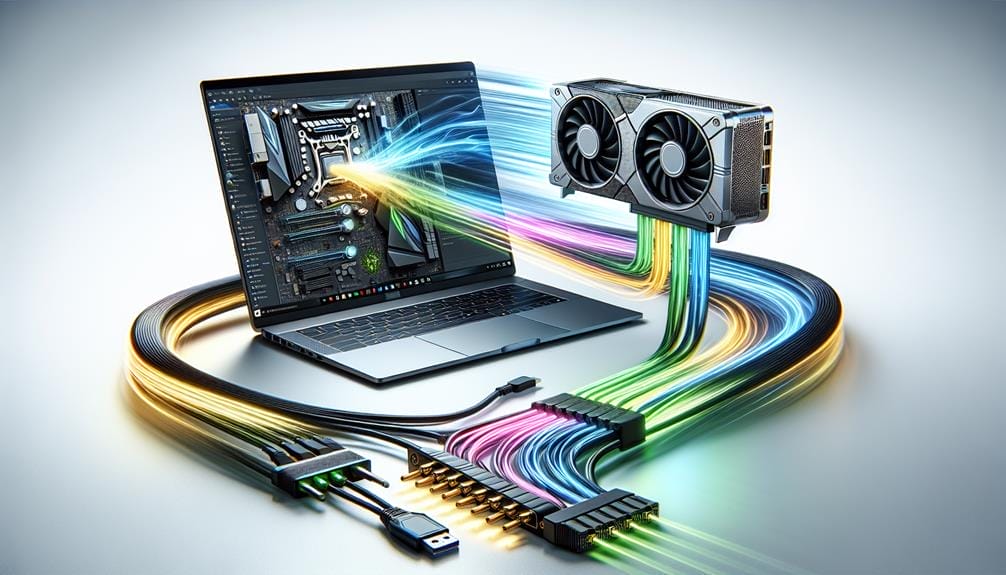
External GPUs, also known as eGPUs, have emerged as a versatile solution for enhancing the graphics capabilities of laptops, mini PCs, and compact form factor systems. These external enclosures offer several advantages and compatibility with different devices:
- Enhanced Graphics Performance: eGPUs provide a significant boost in graphics processing power, enabling smoother gaming experiences and improved multimedia editing on devices with integrated graphics.
- Upgradability: They allow users to upgrade their graphics performance without replacing their entire system, providing a cost-effective option for enhancing existing hardware.
- Versatility: eGPUs are compatible with a wide range of devices, including laptops, mini PCs, and compact form factor systems, adding flexibility to users' computing setups.
- Portability: Users can easily detach the eGPU from their device, making it a convenient solution for those who require both portability and high-performance graphics capabilities.
- Future-Proofing: eGPUs offer a way to future-proof devices by allowing for graphics performance upgrades as newer and more demanding applications and games are released.
Connectivity Options for Laptops
As laptops continue to evolve, the connectivity options available for users have become increasingly diverse and integral to the overall functionality and versatility of these devices.
External Graphics Cards (eGPUs) are a popular choice for enhancing the graphics performance of laptops, but they come with limitations. While eGPUs provide a significant boost in graphics power, there can be a performance loss depending on the bandwidth of the Thunderbolt connection, impacting their effectiveness for demanding tasks.
On the other hand, dedicated graphics cards integrated into laptops offer advantages for gaming, providing high graphical prowess and a dedicated memory pool. These cards ensure smoother gameplay and better rendering capabilities, making them a preferred choice for gaming enthusiasts.
Understanding the limitations of eGPU technology and the advantages of dedicated graphics cards is crucial for users seeking optimal graphics performance for their laptops.
Conclusion
In conclusion, the world of GPUs offers a diverse range of options. This includes dedicated graphics cards, AIB GPUs, and various designs catering to different use cases. Understanding the characteristics and considerations associated with each type is crucial in selecting the most suitable GPU for individual requirements.
Whether for gaming, professional work, or general use, the multifaceted landscape of GPUs provides ample choices for users seeking the ideal graphics solution.

